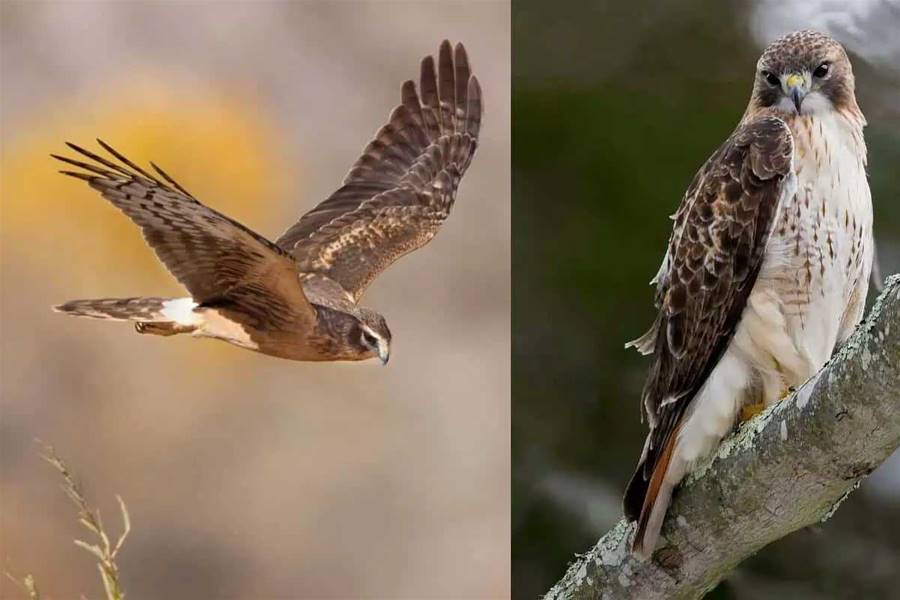

Hawks, sometimes revered and sometimes feared, are powerful hunters. Some soar vast distances over open landscapes, while others tear through forests and breakneck speed. Known for their keen eyesight, screeching call, sharp talons and hunting prowess, they make up a large portion of the “birds of prey” category. In this article, we are going to look at all of the types of hawks you can find in the United States.
It is currently thought that there are about 16 species of hawks throughout the United States. This is excluding the rare vagrants that may occasionally be spotted.
If you want to find out which hawk species you can find in a specific state, .
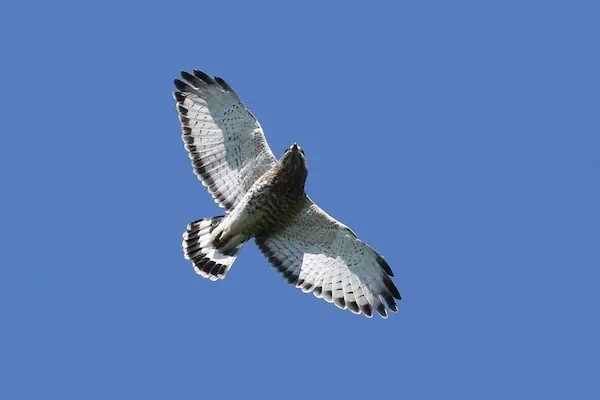
Scientific name: Buteo platypterus
Length: 13.4-17.3 in
Weight: 9.3-19.8 oz
Wingspan: 31.9-39.4 in
spend their winters down in Southern and Central America, and only come up to the U.S. to breed in the spring and summer.
These smaller hawks have a brown head and chest, barred underparts and black and white bands on their tail. In flight you can note their short tail and broad wings with pointed tips.
These hawks like to be in a secluded area during breeding season. They will nest in forests and along bodies of water far from humans. Their diet is a variety of small mammals, insects, and amphibians such as frogs and toads.
If you are hoping to see the broad-winged hawk, your best bet is during fall migration on their way back South America. Flocks called “kettles”, that can contain thousands of birds, circle in the sky.

Scientific name: Buteogallus anthracinus
Length: 16.9 – 22.1 in
Weight: 27.9 oz
Wingspan: 46.1 in
The common black hawk is rare in the U.S. overall, living mostly in Mexico, Central America and northern parts of South America. However some of them do cross the border into the U.
These hawks are a sooty black color all over, with a thick white band in the middle of their tail, and a thinner white strip at the tail tip. Forested areas along streams or river, inside of canyon and desert habitats, is where you can find the common black hawk. They like to hunt along streams and rivers, sitting up in a perch and watching for prey down below. This can include fish, reptiles, small mammals, crayfish, frogs and snakes.
Interestingly, they have sometimes been observed wading into shallow water and waving their wings, herding fish into shallow water on the shore where they can more easily grab them.
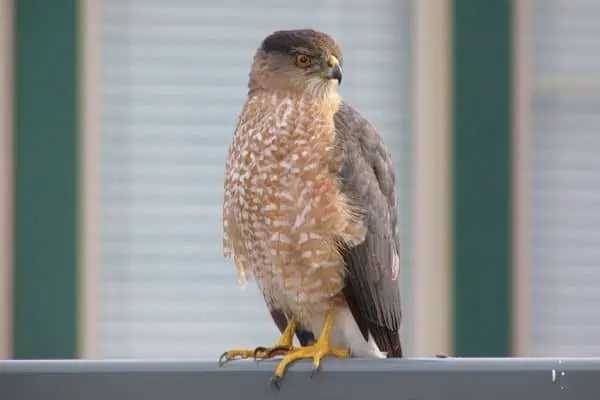
Scientific name: Accipiter cooperii
Length: 14.6 – 17.7 in
Weight: 7.8 – 24.0 oz
Wingspan: 24.4-35.4 in
can be found across the entire U.S. For most states they remain year-round, while states along the northern border tend to only see them during the spring and summer months.
Adults have a bluish-gray back, heavy orange barring on the chest, a red eye, and squared-off head with black cap.
Their habitat is forests and woodlands, but they also seem fairly at home in the suburbs. Their main food source is small birds, which they deftly hunt in the tree canopy. Many people encounter the Cooper’s hawk in their backyard, where they have been known to go after birds at a bird feeder, especially starlings, doves and pigeons.
Crashing through trees and foliage on a high speed chase after birds does take its toll, and studies of Cooper’s hawk skeletons reveal that many of them had at one point broken bones in their chest.
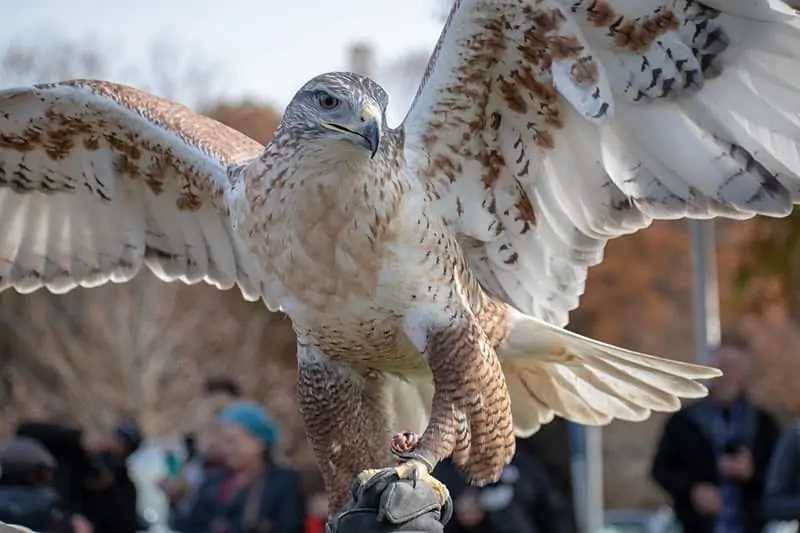
Scientific name: Buteo regalis
Length: 22.1-27.2 in
Weight: 34.5-73.2 oz
Wingspan: 52.4-55.9 in
Ferruginous Hawks are birds of the western U.S. They breed in Nevada, Utah and states north, while tending to only be winter visitors to areas along the Mexican border. Ferruginous hawks tend to stay in open spaces like fields and plains, soaring above looking for small mammals or hunting on the ground.
These hawks are the largest of all North American hawks.
Ferruginous Hawks are known for gathering in groups of 5-10 to ambush prairie dogs. They perch and wait for prey to peek out their burrows before striking. This creates quite a scene as the hawks begin hopping and flapping their wings, often attracting other hawks and birds of prey.
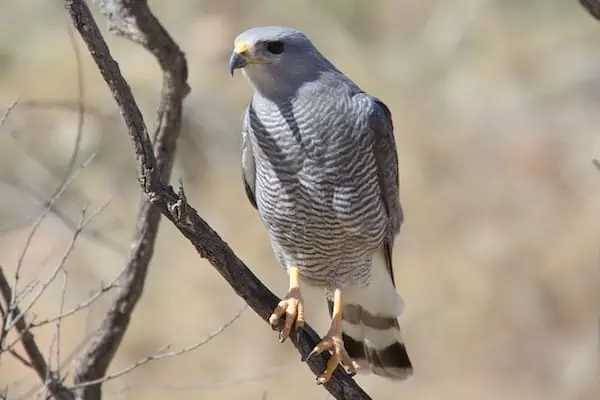
Scientific name
The gray hawks is thought of as mainly a tropical species, at home in coastal Mexico and Central America. However some do cross the border during the breeding season into areas of Texas, Arizona and New Mexico. Look for them along rivers flanked with cottonwood and willow trees. They are hard to spot while perched in the tree canopy, but you can find them soaring during late morning and afternoon.
Gray hawks are medium-sized with long black and white banded tails. They have a solid gray head and back, while their underparts are barred gray and white. Reptiles such as spiny lizards, tree lizards, snakes and toads make up a lot of their diet.

Scientific name: Parabueto unicinctus
Length: 18.1 – 23.2 in
Weight: 18.2 – 31.0 oz
Wingspan: 40.5 – 46.9 in
Harris’s hawk are found from South America to Mexico, so those in the U.S. are at the very northernmost point of their range. The only places to see them in the United States are southern Texas, Arizona and parts of New Mexico.
These large hawks have dark bodies with rusty red shoulders. There is bright white at the base of their tail as well as the tips, with a dark band in-between. These are hawks of desert lowlands, feeding on ground squirrels, rodents, rabbits, reptiles and birds. They can be social birds, hunting in cooperative groups or even nesting in social units of up to seven adults.
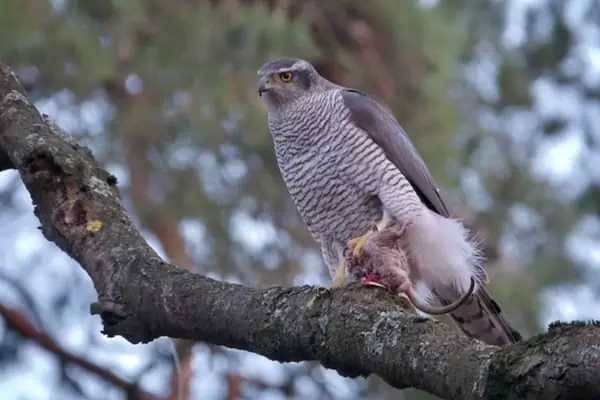
Scientific name: Accipiter gentilis
Goshawks have a gray back, gray barring on the chest that extends all the way down the belly, and a thick what stripe over each eye. They are considered larger and fiercer relatives of the sharp-shinned and cooper’s hawk. But unlike those hawks that are common in backyards, goshawks are quite secretive and tend to remain in the forest, avoiding human populated areas.
Northern Goshawks remain year-round across Canada, Alaska, New England, the Great Lakes, and down through the Rockies.
However you likely won’t have an easy time finding one, since they prefer to nest in old-growth forest with dense canopy. They have been known to attack humans who get too close to their nests. So when searching for these raptors during the breeding season, be careful.
The northern goshawk has a varied diet of smaller hawks, birds, mammals, reptiles and even insects and carrion. They are considered uncommon, and their population is hard to estimate due to their secretive nature.
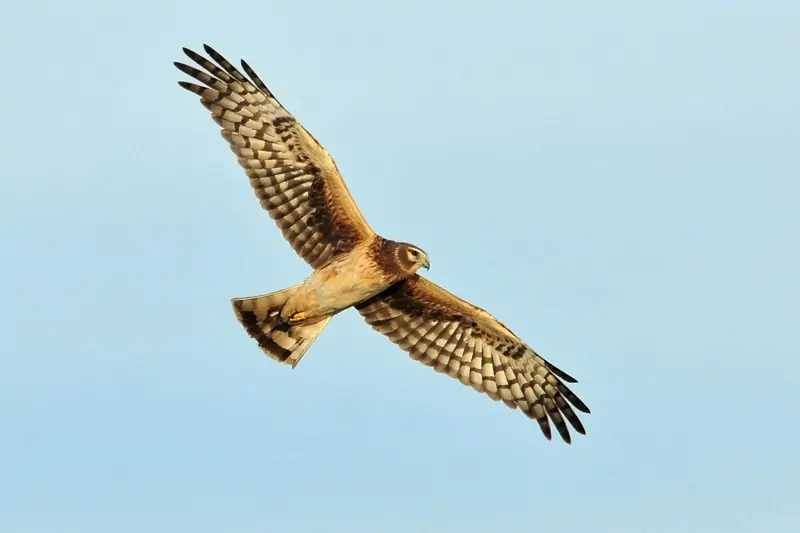
Scientific name: Circus hudsonius
Length: 18.1-19.7 in
Weight: 10.6-26.5 oz
Wingspan: 40.2-46.5 in
The northern harrier has an elegant, almost owl-like face. This disc-shaped face functions similarly to an owls, directing sound into their ears to help them hunt by sound as well as sight. Two helpful identifying features are their long tail, and white patch above the tail. They have a signature flying style, holding their wings in the shape of a “V”.
You can find this hawk in the summer breeding throughout Canada and the northern U.S. then moving to the southern states during the winter months. In the middle of the country, many remain year-round.
Unlike many hawks that nest in trees, this hawk builds a platform on the ground in dense vegetation like reeds, willows, sedges and cattails. Males can have two (sometimes more) mates at once, and they will provide food for the female and offspring.
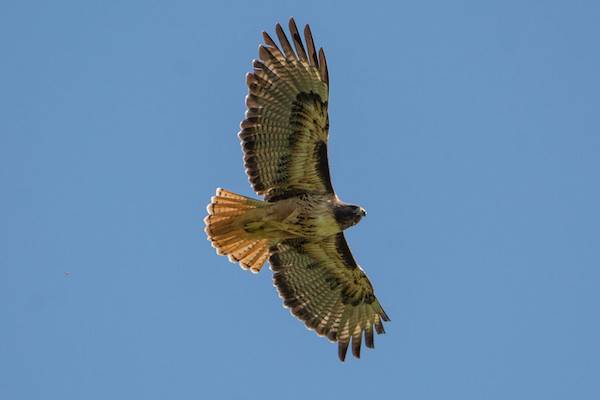
Scientific name: Buteo jamaicensis
Length: 17.7 – 25.6 in
Weight: 24.3oz – 51.5 oz
Wingspan: 44.9-52.4 in
are the most common hawk found in North America. They can be seen in every state in the continental U.S. Their population increases even more during the winter, when birds that have spent their summer in Canada come down to join the others in the U.S.
Red-tailed hawks are most active during the day or early morning and are commonly seen soaring looking for prey with their amazing vision or perched along the roadside on telephone poles.
Adults have a brick-red tail that is easy to identify, however while still juveniles their tail is brown and white striped. In general these hawks are pale below and dark brown above. They have brown streaking on their breast, often with a band of darker brown streaks going across their belly area that can be another good identifying factor. Because these hawks are so widespread, there are many color variations across the country.
The red-tailed hawk gives out a long screech that has become a representation for all raptors.
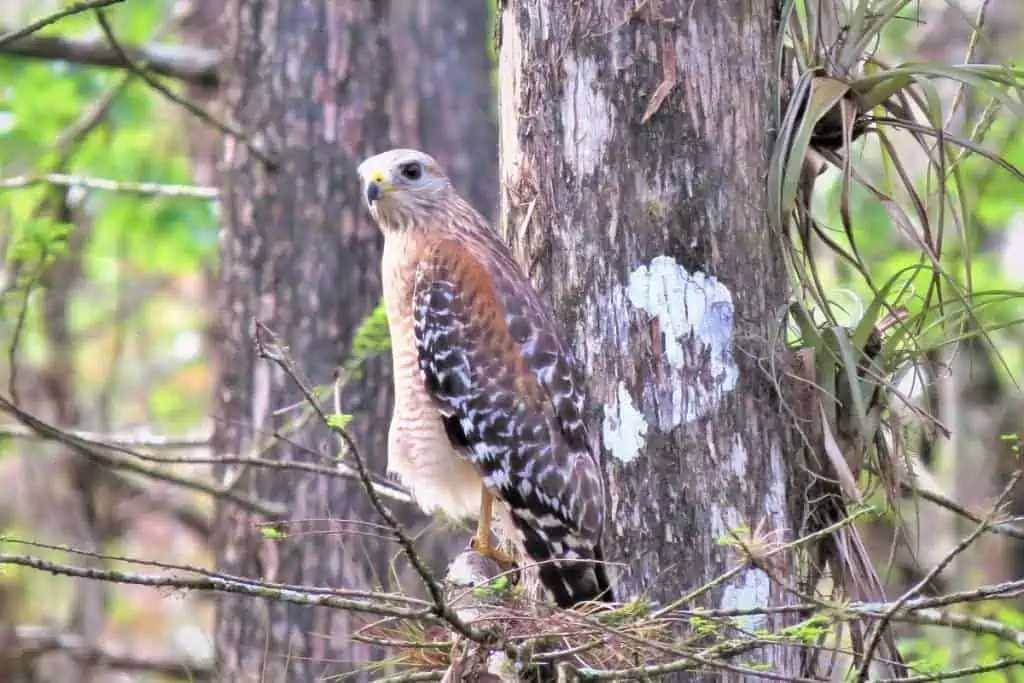
Scientific name: Buteo lineatus
Length: 16.9-24.0 in
Weight: 17.1-27.3 oz
Wingspan: 37.0-43.7
Red-shouldered hawks are common in their range, which is the eastern U.S. and the western coast of California.
A good identifying feature is the heavy red coloring on the breast that extends all the way down their belly with red barring.
You may hear this hawk before you spot it. They give a loud “kee-aah” call that is usually repeated several times in a row. Some people think it sounds a bit like a seagull. They will loudly call to mark territory or when alarmed.
These hawks live and hunt in the forest, and especially like flooded areas and wetlands.
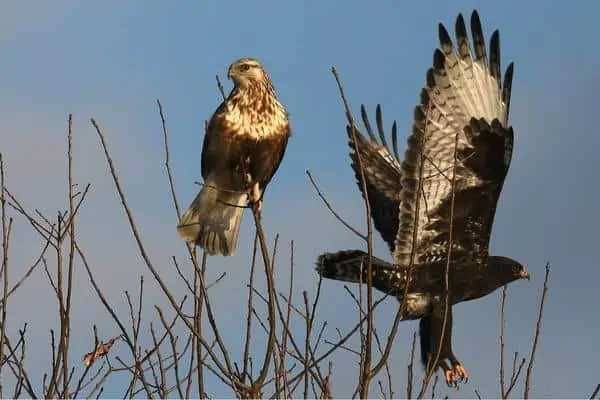
Scientific name: Buteo lagopus
Length: 18.5-20.5 in
Weight: 25.2-49.4 oz
Wingspan: 52.0-54.3 in
Rough-legged hawks can be seen in most U.S. states except for the southeast, but only during the fall and winter months.
In the winter, you’ll find them in the states in wide-open spaces, perching on poles and fence posts. Here they hunt for mice, voles and shrews. Rough-legged hawks are known to turn into the wind and flap their wings to achieve a hover-in-place vantage point they can use to scan the ground below them for their prey.
Rough-legged hawks get their names from the feathers on their legs. Very few American raptors have feathers that run all the way down their legs.
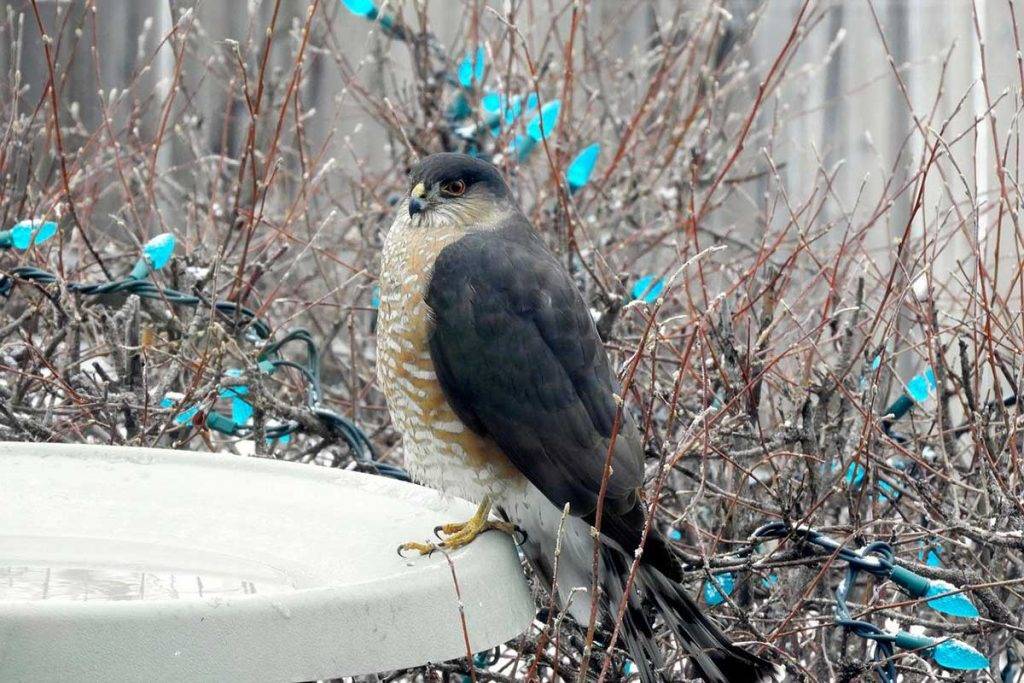
Scientific name: Accipiter striatus
Length: 9.4-13.4 in
Weight: 3.1-7.7 oz
Wingspan: 16.9-22.1 in
are the smallest hawk in the United States, and can be found in most states.
These hawks prey on small birds and rodents they chase through the forest. While nesting, they are hard to find as they stick to forests with dense canopies. They do sometimes visit backyards to hunt birds at feeders.
The best time to spot them though is during fall migration. They travel south into the U.S. from their summer range in Canada, and are seen in large numbers at hawk watch sites.
Sharp-shinned Hawks have a blue-gray back with reddish-orange barring on their cream colored chests and dark banding on their tails.
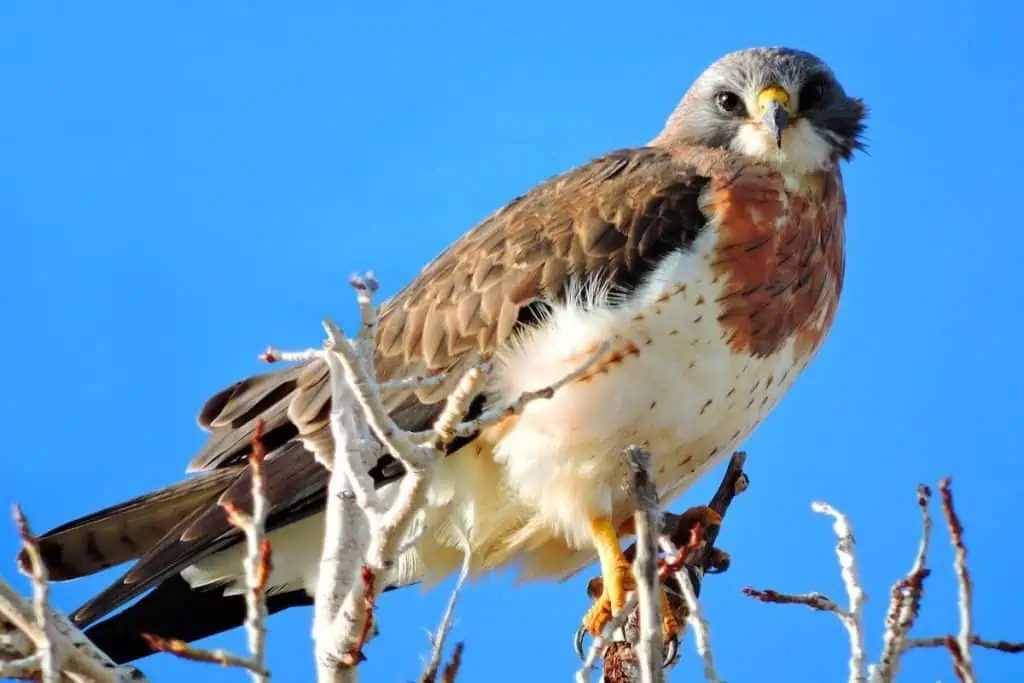
Scientific name: Buteo swainsoni
Length: 18.9-22.1 in
Weight: 24.4-48.2 oz
Wingspan: 45-55 in
Swainson’s Hawks can be found during the spring and summer breeding season across the central and western U.S., although they are less common along the west coast. You are likely to find them over large areas of open country.
Migrating hawks are called kettles, and these Hawks have kettles as large as tens of thousands.
Swainson’s Hawks have converted well to agricultural settings as their habitat has changed over the years. You can find them foraging for prey in crops and fields.
They have a gray head, with white on the chin, a brown bib, and a white belly streaked with rust. When viewed from below look for the brown chest, and wings that appear extra long with dark edges.
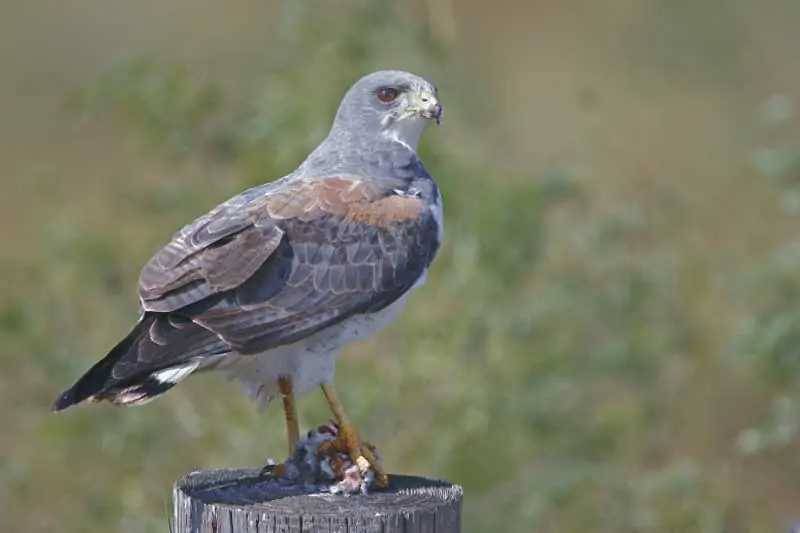
Scientific name:
Length: 17-24 in
Weight: 31.0-43.6 oz
Wingspan: 46-56 in
This neotropical raptor is common in Central and South America, but not at all in North America. In fact, Texas may be the only state in North America where you’ll find the White-tailed Hawk, and only in the southern tip of the state. Random sightings have been reported in neighboring states but they were likely vagrants and very uncommon.
This bird is not migratory but may make regional movements in search of food. They are typically gray on top and white below, but like a couple of the others on this list there is a dark and light morph of this species of hawk.
As you would expect, their name comes from their tail which is mostly white with a thick dark bar at the tip. Their diet mainly consists of rats, mice, pocket gophers, rabbits, birds, snakes, lizards, frogs, crayfish, crabs, insects.
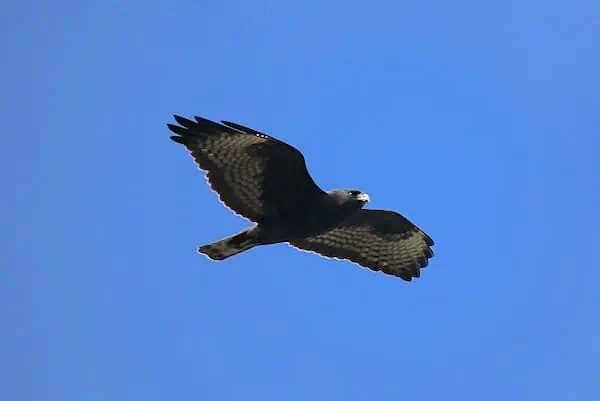
Scientific name:
Length: 15.3 – 17.3 in
Weight: 13.6 – 16.9 oz
Wingspan: 32.7 – 40.5 in
The only reason the short-tailed hawk makes this list is because a population of about 500 of them live in Florida.
They occur in both a light and dark morph, with the dark being more common in Florida. Smaller birds make up a large portion of their diet, everything from sparrows to mourning doves. Frogs, lizards, snakes and small mammals are also hunted.
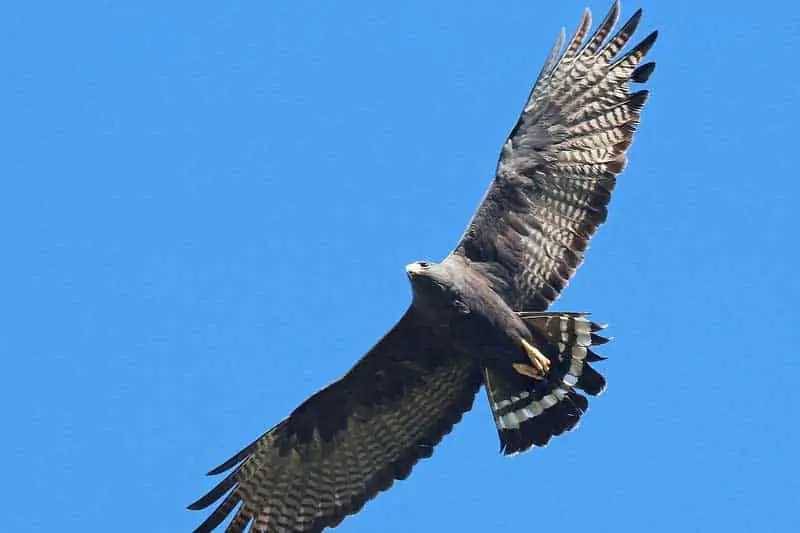
Scientific name
The zone-tailed hawk only visits Arizona and New Mexico, coming up from south of the border during the spring and summer months. They like rocky canyons and cliffs, as well as hunting in desert scrub and along rivers. Aside from small mammals and reptiles, they are known to eat many types of birds including quail, woodpeckers, jays, nightjars, and members of the thrush family like bluebirds and robins.
The way they arch their wings while soaring and tip from side to side, plus their coloring, often makes them resemble a turkey vulture from afar. Upon closer inspection you can see the large white band on the tail, and barring on their white wing feathers with a dark trailing edge.
